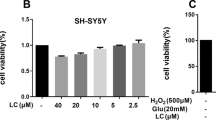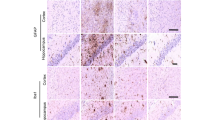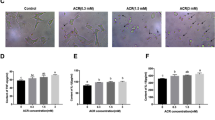Abstract
Acrylamide (AM) is a potent neurotoxin and carcinogen that is mainly formed by the Maillard reaction of asparagine with starch at high temperatures. However, the toxicity mechanism underlying AM has not been investigated from a proteomic perspective, and the regulation of protein expression by AM remains poorly understood. This research was the first to utilize proteomics to explore the mechanism of AM exposure-induced neuroinflammation. Target proteins were obtained by differential protein analysis, functional annotation, and enrichment analysis of proteomics. Then, molecular biology methods, including Western blot, qPCR, and immunofluorescence, were used to verify the results and explore possible mechanisms. We identified 100 key differential metabolites by proteomic analysis, which was involved in the occurrence of various biological functions. Among them, the KEGG pathway enrichment analysis showed that the differential proteins were enriched in the P53 pathway, sulfur metabolism pathway, and ferroptosis. Finally, the differential target protein we locked was LARP7. Molecular biological verification found that AM exposure inhibited the expression of LARP7 and induced the burst of inflammation, while SRT1720 agonist treatment showed no effect on LARP7, but significant changes in inflammatory factors and NF-κB. Taken together, these findings suggested that AM may activate NF-κB to induce neuroinflammation by inhibiting the LARP7-SIRT1 pathway. And our study provided a direction for AM-induced neurotoxicity through proteomics and multiple biological analysis methods.




Similar content being viewed by others
Data Availability
The data used to support the findings of this study are available from the corresponding author upon request.
References
Aslam B, Basit M, Nisar MA, Khurshid M, Rasool MH (2017) Proteomics: technologies and their applications. J Chromatogr Sci 55:182–196
Basu A, Krady JK, Levison SW (2004) Interleukin-1: a master regulator of neuroinflammation. J Neurosci Res 78:151–156
Campbell IL, Abraham CR, Masliah E, Kemper P, Inglis JD, Oldstone MB, Mucke L (1993) Neurologic disease induced in transgenic mice by cerebral overexpression of interleukin 6. Proc Natl Acad Sci USA 90:10061–10065
Cantrell MS, McDougal OM (2021) Biomedical rationale for acrylamide regulation and methods of detection. Compr Rev Food Sci Food Saf 20:2176–2205
Cui W, Wu X, Shi Y, Guo W, Luo J, Liu H et al (2021) 20-HETE synthesis inhibition attenuates traumatic brain injury-induced mitochondrial dysfunction and neuronal apoptosis via the SIRT1/PGC-1α pathway: a translational study. Cell Prolif 54:e12964
Elblehi SS, El Euony OI, El-Sayed YS (2020) Apoptosis and astrogliosis perturbations and expression of regulatory inflammatory factors and neurotransmitters in acrylamide-induced neurotoxicity under ω3 fatty acids protection in rats. Neurotoxicology 76:44–57
Fernández-Mendívil C, Luengo E, Trigo-Alonso P, García-Magro N, Negredo P, López MG (2021) Protective role of microglial HO-1 blockade in aging: Implication of iron metabolism. Redox Biol 38:101789
Guzman JR, Koo JS, Goldsmith JR, Mühlbauer M, Narula A, Jobin C (2013) Oxymatrine prevents NF-κB nuclear translocation and ameliorates acute intestinal inflammation. Sci Rep 3:1629
Hasler D, Meister G, Fischer U (2021) Stabilize and connect: the role of LARP7 in nuclear non-coding RNA metabolism. RNA Biol 18:290–303
Hogervorst J, Vesper HW, Madhloum N, Gyselaers W, Nawrot T (2021) Cord blood acrylamide levels and birth size, and interactions with genetic variants in acrylamide-metabolising genes. Environ Health 20:35
Hoodless LJ, Lucas CD, Duffin R, Denvir MA, Haslett C, Tucker CS et al (2016) Genetic and pharmacological inhibition of CDK9 drives neutrophil apoptosis to resolve inflammation in zebrafish in vivo. Sci Rep 5:36980
Huang M, Jiao J, Wang J, Xia Z, Zhang Y (2018) Characterization of acrylamide-induced oxidative stress and cardiovascular toxicity in zebrafish embryos. J Hazard Mater 347:451–460
Imperatore F, Maurizio J, Vargas Aguilar S, Busch CJ, Favret J, Kowenz‐Leutz E et al (2017) SIRT1 regulates macrophage self-renewal. Embo J 36:2353–2372
Jiang X, Stockwell BR, Conrad M (2021) Ferroptosis: mechanisms, biology and role in disease. Nat Rev Mol Cell Biol 22:266–282
Jiao F, Gong Z (2020) The beneficial roles of SIRT1 in neuroinflammation-related diseases. Oxid Med Cell Longev 2020:6782872
Jin K, Lu J, Yu Z, Shen Z, Li H, Mou T et al (2020) Linking peripheral IL-6, IL-1β and hypocretin-1 with cognitive impairment from major depression. J Affect Disord 277:204–211
Kasahara DI, Wilkinson JE, Cho Y, Cardoso AP, Huttenhower C, Shore SA (2019) The interleukin-33 receptor contributes to pulmonary responses to ozone in male mice: role of the microbiome. Respir Res 20:197
Khader A, Yang WL, Hansen LW, Rajayer SR, Prince JM, Nicastro JM et al (2017) SRT1720, a sirtuin 1 activator, attenuates organ injury and inflammation in sepsis. J Surg Res 219:288–295
Komoike Y, Matsuoka M (2019) In vitro and in vivo studies of oxidative stress responses against acrylamide toxicity in zebrafish. J Hazard Mater 365:430–439
Kopanska M, Muchacka R, Czech J, Batoryna M, Formicki G (2018) Acrylamide toxicity and cholinergic nervous system. J Physiol Pharmacol 69
Krueger BJ, Jeronimo C, Roy BB, Bouchard A, Barrandon C, Byers SA et al (2008) LARP7 is a stable component of the 7SK snRNP while P-TEFb, HEXIM1 and hnRNP A1 are reversibly associated. Nucleic Acids Res 36:2219–2229
Leng F, Edison P (2021) Neuroinflammation and microglial activation in Alzheimer disease: where do we go from here? Nat Rev Neurol 17:157–172
Liu Z, Song G, Zou C, Liu G, Wu W, Yuan T et al (2015) Acrylamide induces mitochondrial dysfunction and apoptosis in BV-2 microglial cells. Free Radic Biol Med 84:42–53
Maraia RJ, Mattijssen S, Cruz‐Gallardo I, Conte MR (2017) The La and related RNA-binding proteins (LARPs): structures, functions, and evolving perspectives. Wiley Interdiscip Rev RNA 8
Mendes KL, de Farias Lelis D, Santos SH (2017) Nuclear sirtuins and inflammatory signaling pathways. Cytokine Growth Factor Rev 38:98–105
Miller CG, Schmidt EE (2020) Sulfur metabolism under stress. Antioxid Redox Signal 33:1158–1173
Najmabadi H, Hu H, Garshasbi M, Zemojtel T, Abedini SS, Chen W et al (2011) Deep sequencing reveals 50 novel genes for recessive cognitive disorders. Nature 478:57–63
Palomo J, Dietrich D, Martin P, Palmer G, Gabay C (2015) The interleukin (IL)-1 cytokine family–Balance between agonists and antagonists in inflammatory diseases. Cytokine 76:25–37
Ramadori G, Lee CE, Bookout AL, Lee S, Williams KW, Anderson J et al (2008) Brain SIRT1: anatomical distribution and regulation by energy availability. J Neurosci 28:9989–9996
Sacks D, Baxter B, Campbell BC, Carpenter JS, Cognard C, Dippel D et al (2018) Multisociety consensus quality improvement revised consensus statement for endovascular therapy of acute ischemic stroke. Int J Stroke 13:612–632
Santhanasabapathy R, Vasudevan S, Anupriya K, Pabitha R, Sudhandiran G (2015) Farnesol quells oxidative stress, reactive gliosis and inflammation during acrylamide-induced neurotoxicity: behavioral and biochemical evidence. Neuroscience 308:212–227
Song G, Liu Z, Wang L, Shi R, Chu C, Xiang M et al (2017) Protective effects of lipoic acid against acrylamide-induced neurotoxicity: involvement of mitochondrial energy metabolism and autophagy. Food Funct 8:4657–4667
Tong D, Zhang J, Wang X, Li Q, Liu LY, Yang J et al (2020) MeCP2 facilitates breast cancer growth via promoting ubiquitination-mediated P53 degradation by inhibiting RPL5/RPL11 transcription. Oncogenesis 9:56
Uchikawa E, Natchiar KS, Han X, Proux F, Roblin P, Zhang E et al (2015) Structural insight into the mechanism of stabilization of the 7SK small nuclear RNA by LARP7. Nucleic Acids Res 43:3373–3388
Yan P, Li Z, Xiong J, Geng Z, Wei W, Zhang Y, Wu G, Zhuang T et al (2021) LARP7 ameliorates cellular senescence and aging by allosterically enhancing SIRT1 deacetylase activity. Cell Rep 37:110038
Yilmaz BO, Yildizbayrak N, Aydin Y, Erkan M (2017) Evidence of acrylamide- and glycidamide-induced oxidative stress and apoptosis in Leydig and Sertoli cells. Hum Exp Toxicol 36:1225–1235
Yu H, Zhang F, Yan P, Zhang S, Lou Y, Geng Z et al (2021) LARP7 protects against heart failure by enhancing mitochondrial biogenesis. Circulation 143:2007–2022
Zakhary SM, Ayubcha D, Dileo JN, Jose R, Leheste JR, Horowitz JM et al (2010) Distribution analysis of deacetylase SIRT1 in rodent and human nervous systems. Anat Rec (Hoboken) 293:1024–1032
Zhang X (2009) Simultaneous exposure to dietary acrylamide and corn oil developed carcinogenesis through cell proliferation and inhibition of apoptosis by regulating p53-mediated mitochondria-dependent signaling pathway. Toxicol Ind Health 25:101–109
Zhang Y, Anoopkumar-Dukie S, Arora D, Davey AK (2020b) Review of the anti-inflammatory effect of SIRT1 and SIRT2 modulators on neurodegenerative diseases. Eur J Pharmacol 867:172847
Zhang F, Yan P, Yu H, Le H, Li Z, Chen J et al (2020a) L ARP7 is a BRCA1 ubiquitinase substrate and regulates genome stability and tumorigenesis. Cell Rep 32:107974
Zhao S, Zhong H, Geng C, Xue H, Wang C, Sun W et al (2021) Comprehensive analysis of metabolic changes in rats exposed to acrylamide. Environ Pollut 287:117591
Zong C, Hasegawa R, Urushitani M, Zhang L, Nagashima D, Sakurai T et al (2019) Role of microglial activation and neuroinflammation in neurotoxicity of acrylamide in vivo and in vitro. Arch Toxicol 93:2007–2019
Funding
This work was supported by the National Natural Science Foundation of China (no. 81602846), the Natural Science Foundation of Shandong Province (no. ZR2021MH145 and no. ZR2022QH164), the Taishan Scholar Project of Shandong Province (no. tsqn201812159), the Key Research and Development Program of Jining Science and Technology(no.2022YXNS148), the Doctoral Fund of Jining NO.1 People’ s Hospital (no. 2021-BS-008), and the Projects of medical and health technology development program in Shandong province (no. 202113050502).
Author information
Authors and Affiliations
Contributions
Material preparation, data collection, and analysis were performed by Jinxiu Guo, Hongjia Xue, Wenxue Sun, Shiyuan Zhao, and Junjun Meng. The first draft of the manuscript was written by Jinxiu Guo. Haitao Zhong, and Pei Jiang supervised the study.
Corresponding authors
Ethics declarations
Ethics Approval
We did not use any human specimens and animal in this research.
Competing Interests
The authors declare no competing interests.
Additional information
Publisher's Note
Springer Nature remains neutral with regard to jurisdictional claims in published maps and institutional affiliations.
Supplementary Information
Below is the link to the electronic supplementary material.
Rights and permissions
Springer Nature or its licensor (e.g. a society or other partner) holds exclusive rights to this article under a publishing agreement with the author(s) or other rightsholder(s); author self-archiving of the accepted manuscript version of this article is solely governed by the terms of such publishing agreement and applicable law.
About this article
Cite this article
Guo, J., Xue, H., Zhong, H. et al. Involvement of LARP7 in Activation of SIRT1 to Inhibit NF-κB Signaling Protects Microglia from Acrylamide-Induced Neuroinflammation. Neurotox Res 40, 2016–2026 (2022). https://doi.org/10.1007/s12640-022-00624-1
Received:
Revised:
Accepted:
Published:
Issue Date:
DOI: https://doi.org/10.1007/s12640-022-00624-1




